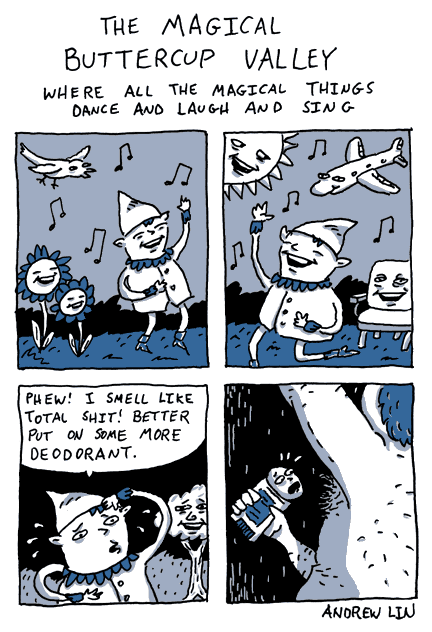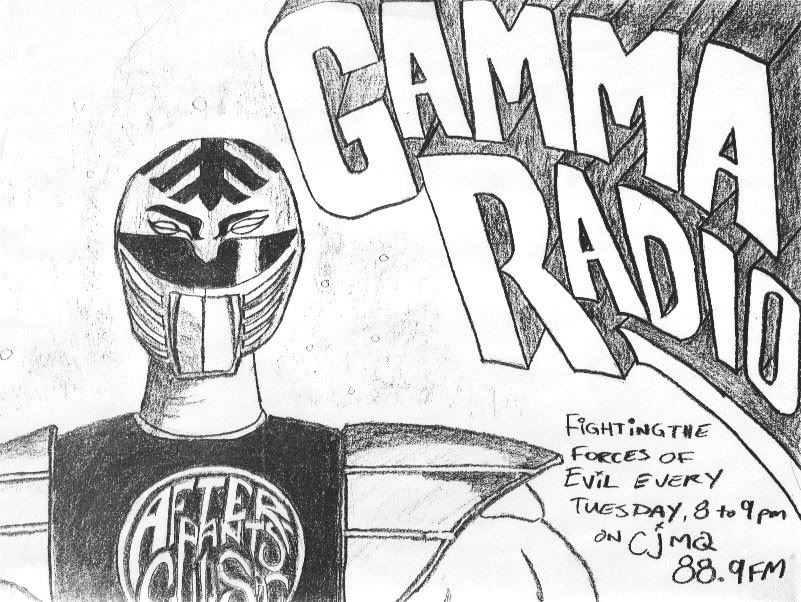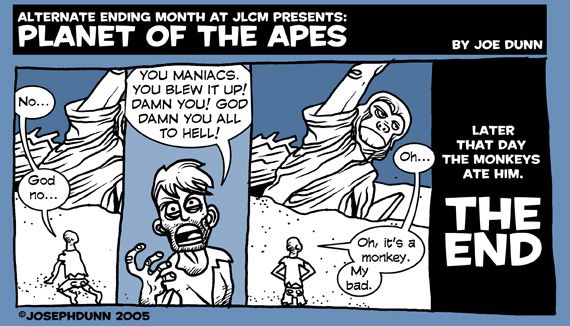I was looking for a blog about octopusses when I came across this. I read it and thought it was SCATHING. That's kind of fun. Thought some folks might be interested i nthe topic. I like how the guy who wrote it is so mean. : ) i included one of the comments at the end because it gave me a case of the chortles.
Enjoy religious banter. . TODAY!
April 27, 2006 The Case Against The Da Vinci CodeI cannot pretend that The Da Vinci Code is a well-written book; but if it were merely a jumble of cliches, there would be little need to write against it. The Da Vinci Code does not ask to be judged on literary merit. The first page reads: "FACT:...All descriptions of artwork, architecture, documents, and secret rituals in this novel are accurate," and Dan Brown has made it clear in interviews that he thinks he's compiled a little encyclopedia of wisdom disguised as a thriller. Certainly his fans, or at least the ones I've spoken with, believe the book is more or less true, the kind of thing we might expect from a historical novel. But Brown's history is fantasy, and the accurate texts he describes don't say what he pretends they do. I suppose it would be possible to enjoy The Da Vinci Code as a goofy chase novel, but turning to it for facts on the history of religion is like turning to a Tarzan movie for facts on African ecology. There are some good fight scenes, but now you think lions live in the jungle.
In this essay, I'm going to be pointing out some of Dan Brown's more egregious errors and fabrications. There's really no reason to take my word for any of this, but the documents Brown cites are, by and large, easily available, and I encourage everyone to read them to check who's right (
www.gnosis.org is a particularly helpful resource for primary texts). I am by no means an expert, but I was a religion major in college, and I've read a few books that were not written by crackpots, so I am not wholly ignorant on the history of religion. In this way I am different from Dan Brown.
All references to page numbers are to my copy of The Da Vinci Code (NY: Doubleday, 2003). I'm trying to keep this essay as neutral and accurate as possible, so any corrections or additions are of course welcome.
Brown's main thesis (which he is unable wholly to conceal was lifted from Baigent, Leigh, and Lincoln's Holy Blood, Holy Grail, a book just as crazy but slightly less stupid than The Da Vinci Code) is that Jesus married Mary Magdalene and had a child. Brown throws in a whole bunch of distractions, such as what Leonardo Da Vinci may or may not have believed about the whole thing, which are pretty silly when you start to think about them, but it's his bloodline of Christ thesis that's the heart of the book, and it's the one I intend to look at in the most depth, since 1. it's the part that people keep citing as fact and 2. it's something I know something about, (unlike, say, Parisian architecture).
The evidence Brown presents for this thesis is laid out by annoying eccentric Sir Leigh Teabing and smug "symbologist" (semiotician was too hard to spell) Robert Langdon in an interminable lecture to the unbelievably naive Sophie Neveu that takes up most of chapters 58-61, and falls broadly into three branches: The Dead Sea Scrolls evidence, the Nag Hammadi evidence, and the "mandatory marriage" argument. So let's take them one by one.
The Dead Sea Scrolls
Brown seems to think that the Dead Sea scrolls and the documents found at Nag Hammadi both contain Gnostic gospels (p 245). I can only assume Brown never read the Dead Sea scrolls, or even read about them, and just thought the name sounded cool. The Dead Sea scrolls are not, as he claims, "the earliest Christian records" (p245) but rather the records of a Jewish group in Qumran, probably the Essenes. The records may well predate any Christian writings (the dating is not uncontroversial) but in no way can they be called gospels or Christian. Needless to say they do not mention Jesus getting married; in fact, they do not mention Jesus at all (hardly surprising in Jewish texts that may predate his ministry).
Five minutes with a book like
The Complete Dead Sea Scrolls in English should convince you that Brown is stumbling in the dark. I couldn't find a comprehensive translation of the scrolls online, but
gnosis.org has a selection that may not be as impressive as Teabing's "poster-sized" photocopies, but has the advantage of not being all fabrication.
What does the Gospel of Philip say?
Brown's mention of the Nag Hammadi texts--a collection of Gnostic writings discovered in Egypt in 1945--is a less puzzling, or stupid, choice. Teabing reads from the Gospel of Philip, in Brown's translation:
And the companion of the Saviour is Mary Magdalene. Christ loved her more than all the disciples and used to kiss her often on her mouth. The rest of the disciples were offended by it and expressed disapproval. They said to him, "Why do you love her more than all of us?"
Teabing adds, "As any Aramaic scholar will tell you, the word companion in those days literally meant spouse."
First thing's first. Any Aramaic scholar, when presented with the Gospel of Philip, will tell you, "I can't read this." That's because the Gospel is written in Coptic, a language unrelated to Aramaic. The word in question is a Greek loan word, koinonos. I speak neither Coptic nor Greek, but I bothered to look it up, and this word can mean companion, wife, or spiritual comrade (much as the word sister today can mean female sibling, but is also used with a different meaning by nuns, churchgoers, black women, etc.). Type koinonos and Coptic into google and you'll get the same answer from any number of sites.
This is from the translation of the Gospel of Philip I read (translated by W. W. Isenberg and available at
gnosis.org):
And the companion of the [...] Mary Magdalene [...] loved her more than all the disciples, and used to kiss her on her mouth. The rest of the disciples [...]. They said to him, "Why do you love her more than any of us?"
There are several differences here--for example, this translation was made by someone who knew what language he was translating from--and a quibbler could point out that the lacunae leave open the possibility that this passage may not be about what Brown thinks it's about at all. In fact, this version of the translation has some guesswork in it, too (with words inserted from parallel passages), and a version that more completely reflects the fragmentary nature of the text is at
wikipedia and reads:
And the companion of the [...] Mary Magdalene [...] more than [...] disciples [...] kiss her on her [...]. The rest of the disciples [...]. They said to him, "Why do you love her more than any of us?"
Brown does not quote Jesus' response, which comes in the form of a parable that pretty clearly means that Mary Magdalene understands his teaching better than the rest of the disciples, and that's why she's favored. This is hardly a surprising response, as Gnostic gospels often glorified marginal figures: in the Gospel of Thomas, Thomas has the deepest understanding (and therefore gets special treatment), in the Gospel of Judas, Judas does; here it's Mary Magdalene.
Please note that Jesus' response to the question "Why do you like her better than us?" was not "Because she's my wife, you schmuck."
A few side notes on the Gospel of Philip
We should note that the Gospel of Philip uses the word koinonos in one other place as well, earlier on:
There were three who always walked with the Lord: Mary, his mother, and her sister, and Magdalene, the one who was called his companion. His sister and his mother and his companion were each a Mary.
This is a confusing paragraph: Mary changes from his aunt to his sister, and Mary Magdalene is first identified as "the one who was called his companion" and then "his companion." Depending on the meaning of koinonos, it can make a big difference.
The point is, these are not clear and simple passages, as Brown would have you believe. Even the word "kiss" may not be as sexy as we think it is. We all know that Jesus and Judas kissed at least once;
Romans 16:16 enjoins us to "greet one another with a holy kiss." Look up "kiss" in a biblical concordance and see how many of the references you find are sexual. Certainly we've become accustomed, in a snickering, junior high fashion, to interpreting nonsexual relationships as sexual. "Just think about it," we say while high fiving each other, "Bert and Ernie are totally gay!" It's very easy for us to misinterpret the behaviors of a past not too long gone, a time in which straight people of the same sex used to sleep in the same bed, like Laurel and Hardy, and think nothing of it. The sexual mores of two thousand years ago might be even harder to parse correctly.
Here's what the Gospel of Philip itself has to say about kissing:
For it is by a kiss that the perfect conceive and give birth. For this reason we also kiss one another. We receive conception from the grace which is in one another.
This may not be clear out of context, so here's the complete "saying."
The heavenly man has many more sons than the earthly man. If the sons of Adam are many, although they die, how much more the sons of the perfect man, they who do not die but are always begotten. The father makes a son, and the son has not the power to make a son. For he who has been begotten has not the power to beget, but the son gets brothers for himself, not sons. All who are begotten in the world are begotten in a natural way, and the others are nourished from the place whence they have been born. It is from being promised to the heavenly place that man receives nourishment. [...] him from the mouth. And had the word gone out from that place, it would be nourished from the mouth and it would become perfect. For it is by a kiss that the perfect conceive and give birth. For this reason we also kiss one another. We receive conception from the grace which is in one another.
I suppose a Da Vinci Code apologist could claim that this paragraph sets up a relationship between kissing and paternity, but, really, I think it's clear that we're talking here about spiritual birth, and the power to be reborn by hearing words (or the Word); and spiritual kissing as well.
In The Da Vinci Code, at this point, "Teabing flipped through the book [of Gnostic Gospels] and pointed out several other passages that...clearly suggested Magdalene and Jesus had a romantic relationship" (p246). Brown quotes the best one that I've found, from the
Gospel of Mary Magdalene (which was among neither the Nag Hammadi nor the Dead Sea finds): "Peter said to Mary, Sister we know that the Savior loved you more than the rest of woman" (5:5), which isn't much. Note that in the Papyrus Oxyrhynchus 3525 fragment of the Gospel of Mary Magdalene, Mary Magdalene kisses all the disciples, but not Jesus (I couldn't find the fragment online, but Karen King's translation appears in her book
The Gospel of Mary of Magdala). I'd like to see these several other passages. They can't be all that clear, or Brown would have quoted them instead of the vague and murky section of Philip.
But although Philip is vague and murky, it is Brown's best evidence. Although the reconstruction of the text he gives is (as we saw above) hardly certain, I think it's a pretty plausible reconstruction. And although his is hardly the only way to interpret the Gospel of Philip, it's a possible longshot interpretation. Unlike most of the things Brown says, which are stupid or crazy, it is indeed possible that the text of the Gospel of Philip points to a "romantic relationship" between Jesus and Mary Magdalene. The question at this point becomes: Why should we care what the Gospel of Philip says?
How old is Philip anyway?
Brown has a ready answer: Philip is one of the "unaltered" gospels. It's one of "the earliest Christian records," remember? Brown needs us to believe that all other documents in history are fakes, and one he has arbitrarily designated is the only one that's true.
Experts who know more than I date the Gospel of Philip to the late third century. It might be earlier, but no one thinks it's much earlier. The canonical gospels as we know them, everyone agrees, all date from the first century, except perhaps John, which a minority of scholars put in the opening years of the second. Now, when I refer to experts and scholars, I am referring to secular scholars. These are not people with an axe to grind, these are not Christians looking to shill for a religion. The Vatican did not "get to them," although it might be convenient for Brown to believe it has. That's because either the vast majority of secular scholarship is wrong or Brown is. Could it be that Brown alone knows the true dates of composition of these texts?
The Gnostic gospels could not possibly predate the canonical gospels because Gnosticism as a school of thought did not exist until after the canonical gospels had been written. The only so-called Gnostic gospel with any claim to priority is the Gospel of Thomas. It's a fascinating document, but 1. it's probably not as old as people first thought it to be and 2. it doesn't support any of Brown's claims anyway.
Dating ancient manuscripts is always controversial, but
wikipedia supports the claims about Philip I've made above.
But perhaps you don't want to believe the experts. Perhaps you prefer to come to conclusions on your own. Then just read the
Gospel of Philip and then get a
bible and read one of gospels you find there. I think you'll find that that Gospel of Philip keeps referring to the Gospels in order to contradict them. For example, Philip has:
Some said, "Mary conceived by the Holy Spirit." They are in error. They do not know what they are saying. When did a woman ever conceive by a woman. Mary is the woman whom no power defiled. She is a great anathema to the Hebrews, who are the apostles and the apostolic men. This virgin whom no power defiled [...] the powers defiled themselves. And the Lord would not have said "My Father who is in Heaven" unless he had another father, but would have said simply "My father."
Or again:
Those who say that the Lord died first and [then] rose up are in error, for he rose up first and [then] died.
In both these cases, Philip mentions, and presupposes, an existing order of belief, which can be found in the canonical gospels. The canonical gospels don't refer to Philip, while Philip actually quotes Matthew in the first extract. Philip is written in reaction to the canon. Doesn't this imply that Philip comes later?
And really, I defy anyone to read the Gnostic gospels and the canonical gospels and conclude the Gnostic gospels came first. The canonical gospels are introductory texts: anyone could pick one up and come away with a pretty good idea of what Jesus' ministry was about. The Gnostic gospels (and I'm referring not just to Philip here, but Philip is a prime example) require a prior knowledge of a complicated philosophical system. One is narrative, the other is commentary. When the Gnostic gospels do offer a narrative, we get something like
The Infancy Gospel of Thomas, a narrative designed to fill in the blanks left by the bible.
I suppose it's possible that Constantine somehow managed to doctor all the relevant documents so skillfully that he made the old look new and the new look old--but how likely is that? And why have we never found, among the caches of "unaltered" gospels, actual unaltered gospels? Where's the version of John where the wedding of Canna has Mary Magdalene walking down the aisle? Where's the version of Luke where Jesus says "Blessed are the barren, and the wombs that never bare...except in the case of my wife"? If the Gospels of Philip and Thomas and Mary Magdalene and now Judas survived hidden in the desert, why not these?
The "earliest Christian records," incidentally, are the letters of Paul. I don't think anyone, except Dan Brown, believes otherwise.
By the way, we don't know for sure that the Nicene Council was in the habit of altering any books (as Brown accuses them); we do know, however, that the Gnostics were: at Nag Hammadi was also found a copy of Plato's Republic that had been modified to jibe with Gnostic doctrine. This is hardly the behavior you want from your best witness.
Sir Leigh Teabing was still talking, "I shan't bore you with the countless references to Jesus and Magdalene's union. That has been explored as nauseum by modern historians" (p247).
Brown loves to assure us he has innumerable sources without mentioning what those sources are. And these aren't even primary sources, these are "modern historians." Teabing eventually (p253) coughs up four titles: Picknett & Prince's
The Templar Revelation (1998), Margaret Starbird's
The Woman with the Alabaster Jar (1993) and
The Goddess in the Gospels (1998), and Baigent, Leigh, and Lincoln's seminal
Holy Blood, Holy Grail (1983). It's a little dodgy that, with a mere four titles to produce, Brown came up with two by the same author, but I guess he was hard up to come up with four (although you wouldn't know Starbird (probably not her real name) has two books on the list from The Da Vinci Code, which gives titles but not authors to conceal Brown's desperation). None of the texts listed are scholarly articles appearing in peer-reviewed journals. All are fringe books written by non-experts. If you believe in Atlantis or the power of crystals, you'll want these books on your shelf. Imagine walking into a self-styled Egyptologist's house, and the first three books he pulls out are New Age "pyramid power" paperbacks from the 'seventies, while the fourth is by Aleister Crowley.
The first three books named have something else in common: they were are all inspired by the fourth, and their research draws heavily on it for both guidance and authority. They are essentially commentaries on Holy Blood, Holy Grail.
The work that started it all, Holy Blood, Holy Grail is an all-around better book than The Da Vinci Code, by which I mean it is better written, there's no tacked on love story, and the crazy claims are less overtly stupid. Everything interesting in The Da Vinci Code, (with the exception of the parts on Fibonacci numbers, which presumably come from a children's book) comes from Holy Blood, Holy Grail. "I've never heard of it," Brown makes Sophie say, rather cattily. But the authors of Holy Blood, Holy Grail have sure heard of The Da Vinci Code, and recently sued Brown for swiping their theories, a strange thing to do when you're ostensibly dealing in objective facts. If you're going to read just one crazy conspiracy book this year and you're sick of rereading Foucault's Pendulum, try Holy Blood, Holy Grail. But Brown can't really cite it as a valid historical source; he might as well cite Chariots of the Gods or, for that matter, Preacher comics.
Frankly, the line from the Gospel of Philip quoted above--"The father makes a son, and the son has not the power to make a son"--may not be the clearest statement, but it is still a clearer statement that Jesus had no son than any Brown has conjured up to prove he had.
In summary: The Dead Sea Scrolls do not say Jesus was married. One late text from the fifty-two found at Nag Hammadi may or may not suggest in an obscure passage that Jesus was married; it postdated the canonical gospels by two centuries; it mentions no children.
All Jews got married, right?
"Because Jesus was a Jew," Langdon said... "and the social decorum during that time virtually forbid [sic] a Jewish man to be unmarried. According to Jewish custom, celibacy was condemned... [etc.]" (p245).
We've already seen that Dan Brown never bothered to read, or even watch a TV documentary about, the Dead Sea Scrolls. Maybe if he had, he would have learned about the Essenes, a celibate group of Jews who may have produced these scrolls. Here's Philo of Alexandria, writing in the first half of the first century, on the Essenes:
Furthermore they eschew marriage because they clearly discern it to be the sole or the principal danger to the maintenance of the communal life, as well as because they particularly practise continence. For no Essene takes a wife...[etc.] (Fragment of the Apology for the Jews, XI).
It should be noted that many scholars have theorized that Jesus may have been influenced by the Essenes. When they bring this up they're usually talking about Jesus' thought on the end times or Satan, but if he was going to pick up these thoughts from them, why not their thoughts on marriage, too?
Furthermore, in On the Contemplative Life, III, Philo speaks of another group of Jews who seek after wisdom and therefore habitually do not marry. This doesn't seem to be a separate sect this time, but just an expected characteristic of very religious Jews. (Details such as the celibacy of the Essenses are also mentioned in Josephus, so it's not like Philo is our only primary source for all this; he's just the only primary source I've read.) I don't know of any Philo sites online, but these quotes come from
Three Jewish Philosophers (pp51 & 45 respectively). Philo is a contemporary of Jesus', and the picture he draws of Jewish marriage is very different from Brown's.
Brown's argument would be a strange one even if it were not demonstrably false. You can't really argue, "Jesus wouldn't have done that, it's not the mainstream for Judaism," when, clearly, many of Jesus' teachings are so far outside the mainstream of Judaism that in a few years his followers were no longer even Jews.
Meanwhile, Teabing is still talking:
If Jesus were not married, at least one of the Bible's gospels would have mentioned it and offered some explanation for his unnatural state of bachelorhood (p245).
Now, according to Brown's conspiracy theory, the canonical gospels are mock-ups designed to delude their readers into thinking Jesus was not married. Isn't it strange that the Nicene Council, when they were busy removing the innumerable hypothetical passages on Jesus' marriage from the gospels, never bothered to stick in a "P.S. Jesus never married and has no son"? After all, that was their whole reason for making the changes.
The bible makes no direct references to Jesus' marital state one way or the other, but have a look at
1 Corinthians 9:5:
Don't we have the right to take a believing wife along with us, as do the other apostles and the Lord's brothers and Cephas?
Cephas is another name for Peter (see
John 1:42). If you're going to name someone admirable who is married, don't you think you'd mention Jesus before his brothers and Peter? Wouldn't that be the thing to do if Jesus were married? Bear in mind that this example comes from the earliest Christian records.
The secret society
The holy grail, in Dan Brown's mind, is a collection of documents that overthrows the council of Nicea and proves, among other things, that Jesus was married with children, and that he was not divine, but a mortal. This collection has spent nearly two thousand years in hiding. Why is it hiding?
Brown has an answer, of course. It is that the Catholic Church would destroy the documents, should they get their hands on them. It's a movie-ready scenario: the persecuted underdog that knows the truth has to go underground to save itself from the nigh-omnipotent System. There's something wrong with this scenario, however: the Catholic Church is not the only game in town.
The year is 325. The Grail keepers (the Priory of Sion wasn't founded until 1099 (p157), so I can't call them that yet) have proof that Jesus was a mortal, but they can't reveal the documents in Catholic lands. As it happens, there's a large sect of Christians, called Arians, who also believe that Jesus was mortal. Two centuries after Nicea supposedly silenced all dissent, Arian churches control all of Spain and Italy, much of Germany, and parts of North Africa. Maybe these guys would want to see the documents. You know, the documents that prove they're right and prove the Catholics (only nominally Roman Catholics at this point: Rome is Arian) are wrong. Yet there's no indication that this was ever done.
But Arianism dies out, so perhaps the Grail keepers just missed their window of opportunity. And yet, to the east, there remain Nestorian Christians. Nestorians believe that Christ had a human and a divine nature, and keep the two theologically separate; if the Grail keepers have documents that prove Christ's mortal state, maybe the Nestorians would want to look at them. These would be an invaluable to them, not only in asserting Christ's mortal nature, but also in sticking it to those Catholics who have decreed all Nestorians heretics. Nestorians still exist today throughout Central Asia and into China; if they'd ever been given copies of these documents, none survive.
Starting in 362, the Roman Empire briefly became pagan again under the Emperor Julian. Julian hated Christians, and wrote a famous screed,
Against the Gallileans, condemning them. A generous portion of this work, like much of Julian's writing, survives. Julian was born just six years after the Nicene cover-up would have started; but in all of his writings, including what might be the most damning sustained attack on Christianity until Nietzsche started in, he never once mentions the pre-Nicene beliefs that would have still been in living memory. You'd think he would.
(Julian even directly contradicts Brown by declaring that not Constantine but John the Evangelist contrived the myth that Jesus was divine.)
History has preserved neo-Platonic attacks on Christianity and Jewish attacks on Christianity and Christian attacks on Christianity, yet none of them mention the bloodline of Christ.
There have been hundreds and hundreds of Christian heresies. Pelagianism, Patripassionism, Tritheism, Donatism, Montanism--we know about them, and, although the church was certainly at great pains to suppress their belief, it didn't do it by extinguishing the memory of their existence. We can read about heresies in Augustine and Tertullian and Origen--in fact, we can read them all at
gnosis.org. You'll note that the orthodox writers here often choose to describe the heresy before they refute it. None of them mention the bloodline of Christ.
What makes this one heresy so special that it needs to be treated differently, not refuted but forgotten? What makes the idea that Jesus had a child more threatening to the church than the idea that Jesus didn't die on the cross, or that he was just another prophet?
You know what it's really hard to keep for two millennia? A secret. Especially when the members of the Priory of Sion keep dropping hints, as Leonardo is supposed to be doing in his paintings, or Disney in his movies. And has any secret society ever existed for two thousand years? It's hard enough to find human institutions that have lasted two thousand years (although of course they do exist), let alone secret institutions.
Needless to say, the first thing secret societies do when they start is invent a history. The Freemasons really have been around for centuries, but their mythology has them existing for millennia. The history of the Priory of Sion, most non-thriller writers believe, is a hoax. At this point we should all read Umberto Eco's opening essay from
Interpretation and Overinterpretation.
Those darn men!
Even when he departs from his favorite topic, Brown's grasp of history is a joke. He writes:
[The church's] brutal crusade to "reeducate" the pagan and feminine-worshipping religions spanned three centuries, employing methods as inspired as they were horrific.
The Catholic Inquisition published the book that arguably could be called the most blood-soaked publication in human history. Malleus Maleficarum--or The Witches' Hammer--indoctrinated the clergy how to locate, torture, and destroy them. ...During three hundred years of witch hunts, the Church burned at the stake an astounding five million women. (p125)
Now, nobody wants to defend the Inquisition, but Brown's indictment is a muddle. The Malleus Maleficarum was published (not by the Inquisition) in 1487; it was in this era that witch hunts as we know them started. Are we really supposed to believe that Europe was chock full of pagans in the fifteenth century? What three hundred years is he referring to here? Incidentally, the Malleus Maleficarum, while indisputably an influential book, was, according to
wikipedia, in fact condemned by the Inquisition in 1490.
Also, I'd like to see Brown's source for that five million figure. Best bets are either he made it up or got it from a Blue Moon and Stars catalog.
Brown continues: "The male ego had spent two millennia running unchecked by its female counterpart" and now "today's world" is marked by testosterone-fueled wars, a plethora of misogynistic societies, and a growing disrespect for Mother Earth" (pp126-7). Now I hate the modern world as much as anyone, but what kind of fairyland does Dan Brown live in that he thinks the pagan world lacked wars, "testosterone-fueled" or otherwise? The classical pagan virtues are warrior virtues after all. (As for the rest of it: I can't even figure out what misogynistic societies he's talking about--the Rotarians? the Playboy Club?--and in what conceivable way is disrespect for "Mother Earth" "growing"? The phrase "Mother Earth," like the ecology movement and the movie Ferngully: The Last Rainforest, didn't even exist fifty years ago.)
Brown's not completely wrong here: there really were witch hunts and the church really did suppress and supplant paganism. But he's so naturally lazy and mendacious that he can't help but bungle the facts and get mixed up in meaningless Cosmo rhetoric.
Also
While we're at it, phi does not equal 1.618 (p93) any more than pi equals 3.141. It's an irrational number, Would it kill him to look this stuff up?
And finally, there's the claim: "In ancient Greek, wisdom is spelled S-O-F-I-A" (p321). No; no it isn't.
In conclusion
Dan Brown, like most con artists, preys upon the ignorance of his victims. Since he's writing about subjects most people don't know much about, he feels free to make things up and pass it all off as history. There's about as much evidence that Jesus was married with children as there is that he had a peg leg.
It's probably the case that Brown's primary error is not one of fact but of interpretation. The fact that he's willing to make things up to justify his theories merely makes him unscrupulous and amoral--his real problem is that he doesn't know how to analyze any of the facts he has. Everything falls into place for him because he never stops to think whether a possible connection is probable.
If every time you see a circle you see a "feminine circle of protection" (p45), you're going to see a lot of feminine symbols; if you don't realize that circles can mean other things, too, you're going to be misinterpreting some things. Sophie claims skill in "extracting meaning from seemingly senseless data" (p78); but sometimes data is senseless, like a Rorschach blot, and what you're extracting from it is not meaning. "Of course, the Little Mermaid's flowing red hair was certainly no coincidence either" (p262). Of course.
I leave this to a hermaneuticist; our concern here is with historical facts as best we can determine them. Don't take the word of a charlatan with a bad prose style. Read the texts he ineptly tries to cite; read some background by real scholars (I recommend Elaine Pagels's
The Gnostic Gospels).
Make sure to read my upcoming essays, "Why We Love The Da Vinci Code" and "Infelicity and Cliche: Style in The Da Vinci Code" (featuring sentences like: "The epithet, despite sounding flattering, was really quite to the contrary" (p157).
And if you're really desperate to believe an implausible conspiracy theory disguised as a novel, try
Illuminatus!, which is a great book and has John Dillinger in it. Anything but The Da Vinci
Code.posted by halifax ::
email ::
04:10 AMComments: The Case Against The Da Vinci Code
Jesus had a peg leg?!
What a scoop!
posted by N. at April 27, 2006 10:38 AM [
+] 205















